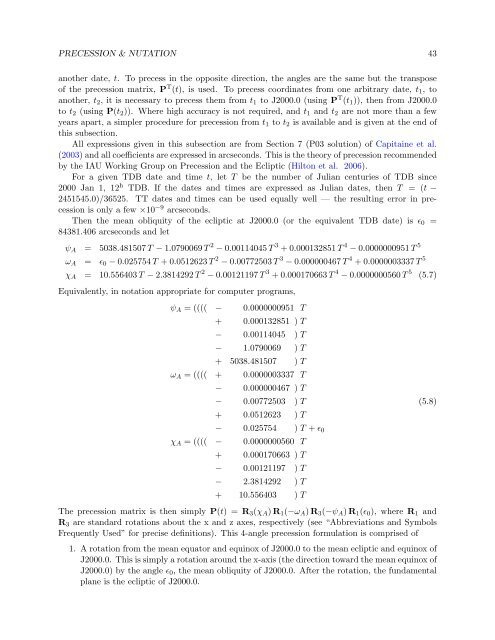USNO Circular 179 - U.S. Naval Observatory
USNO Circular 179 - U.S. Naval Observatory
USNO Circular 179 - U.S. Naval Observatory
Create successful ePaper yourself
Turn your PDF publications into a flip-book with our unique Google optimized e-Paper software.
PRECESSION & NUTATION 43<br />
another date, t. To precess in the opposite direction, the angles are the same but the transpose<br />
of the precession matrix, P T (t), is used. To precess coordinates from one arbitrary date, t1, to<br />
another, t2, it is necessary to precess them from t1 to J2000.0 (using P T (t1)), then from J2000.0<br />
to t2 (using P(t2)). Where high accuracy is not required, and t1 and t2 are not more than a few<br />
years apart, a simpler procedure for precession from t1 to t2 is available and is given at the end of<br />
this subsection.<br />
All expressions given in this subsection are from Section 7 (P03 solution) of Capitaine et al.<br />
(2003) and all coefficients are expressed in arcseconds. This is the theory of precession recommended<br />
by the IAU Working Group on Precession and the Ecliptic (Hilton et al. 2006).<br />
For a given TDB date and time t, let T be the number of Julian centuries of TDB since<br />
2000 Jan 1, 12 h TDB. If the dates and times are expressed as Julian dates, then T = (t −<br />
2451545.0)/36525. TT dates and times can be used equally well — the resulting error in precession<br />
is only a few ×10 −9 arcseconds.<br />
Then the mean obliquity of the ecliptic at J2000.0 (or the equivalent TDB date) is ɛ0 =<br />
84381.406 arcseconds and let<br />
ψA = 5038.481507 T − 1.0790069 T 2 − 0.00114045 T 3 + 0.000132851 T 4 − 0.0000000951 T 5<br />
ωA = ɛ0 − 0.025754 T + 0.0512623 T 2 − 0.00772503 T 3 − 0.000000467 T 4 + 0.0000003337 T 5<br />
χA = 10.556403 T − 2.3814292 T 2 − 0.00121197 T 3 + 0.000170663 T 4 − 0.0000000560 T 5 (5.7)<br />
Equivalently, in notation appropriate for computer programs,<br />
ψA = (((( − 0.0000000951 T<br />
+ 0.000132851 ) T<br />
− 0.00114045 ) T<br />
− 1.0790069 ) T<br />
+ 5038.481507 ) T<br />
ωA = (((( + 0.0000003337 T<br />
− 0.000000467 ) T<br />
− 0.00772503 ) T (5.8)<br />
+ 0.0512623 ) T<br />
− 0.025754 ) T + ɛ0<br />
χA = (((( − 0.0000000560 T<br />
+ 0.000170663 ) T<br />
− 0.00121197 ) T<br />
− 2.3814292 ) T<br />
+ 10.556403 ) T<br />
The precession matrix is then simply P(t) = R3(χA) R1(−ωA) R3(−ψA) R1(ɛ0), where R1 and<br />
R3 are standard rotations about the x and z axes, respectively (see “Abbreviations and Symbols<br />
Frequently Used” for precise definitions). This 4-angle precession formulation is comprised of<br />
1. A rotation from the mean equator and equinox of J2000.0 to the mean ecliptic and equinox of<br />
J2000.0. This is simply a rotation around the x-axis (the direction toward the mean equinox of<br />
J2000.0) by the angle ɛ0, the mean obliquity of J2000.0. After the rotation, the fundamental<br />
plane is the ecliptic of J2000.0.


